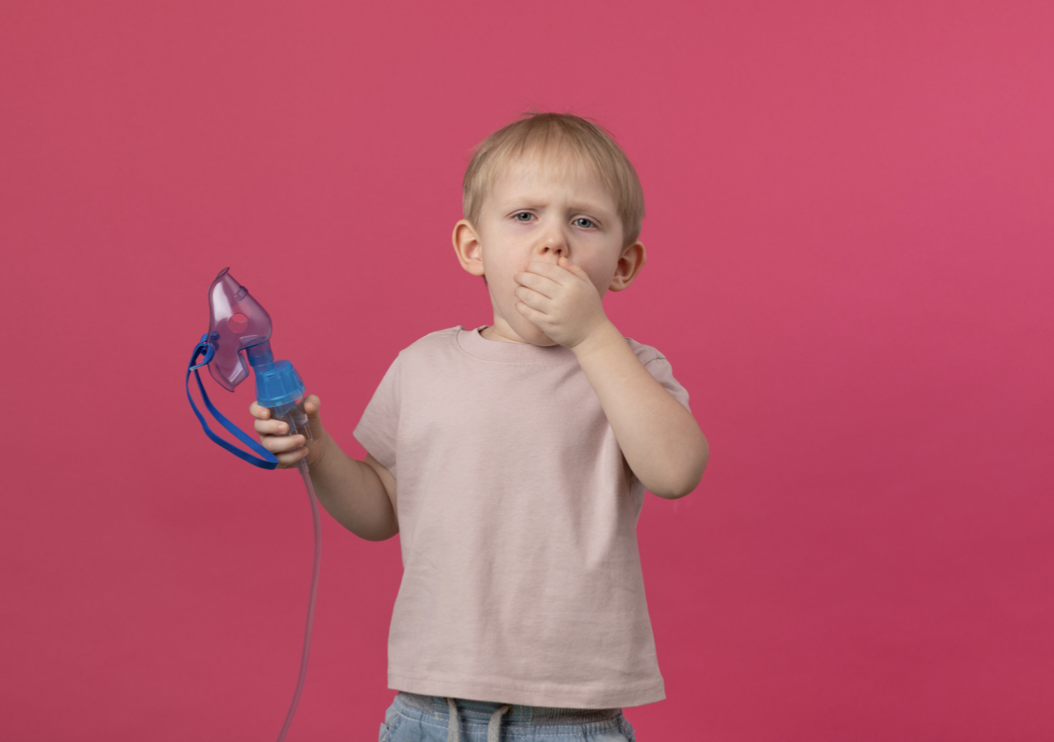Definition
Asthma is a chronic inflammatory airway disease that can cause acute attacks. This condition is common in children and is characterized by sudden and recurrent airway obstruction episodes. This can occur due to swelling, narrowing of the airway muscles (bronchi), and increased respiratory mucus production.
Acute exacerbations in children can occur when the airways are exposed to triggers, such as inhaling dust, cold weather, or infection. Asthma can disrupt children's daily activities, such as playing, exercising, and sleeping. In some children, if their asthma is not controlled because they are not receiving treatment, severe asthma attacks or exacerbations can occur, which can be very dangerous.
Childhood asthma is one of the leading reasons for visits to the emergency department, causing children to become sick and unable to attend school or engage in everyday activities. Because this condition is chronic or long-term, asthma can only be managed to avoid disrupting daily life. With appropriate treatment, parents and children can control asthma symptoms and prevent the occurrence of acute exacerbation episodes that can pose dangers.
Read more: Asthma in children.
Causes
The occurrence of asthma in children is still not fully understood. It is suspected that both genetic factors and environmental exposures during pregnancy and childhood contribute to the development of asthma. A child's history of allergies and a family history of asthma are important factors that interact with environmental factors.
The immune system is more sensitive in children with asthma, which can cause swelling in the airways and excessive mucus production when exposed to certain substances.
Acute exacerbations in asthma can be triggered by various factors, such as:
- Viral infections
- Certain medications
- Exposure to air pollution, cigarette smoke, or combustion smoke
- Foods
- Dust
- Plant pollen
- Animal dander
- Dust mites
- Physical activity
- Emotional stress
- Changes in weather or cold temperatures, etc.
Risk factor
Research suggests that maternal smoking during pregnancy increases the risk of children experiencing wheezing in childhood and developing asthma. Exposure to cigarette smoke is also a trigger for acute exacerbation episodes in children with asthma.
Other factors that can increase the risk of asthma in children include:
- Repeated wheezing until the age of 6 years
- Male gender
- Family history of asthma
- Having atopic or allergic diseases
- Abnormal lung function since childhood
- Premature birth
- Low birth weight
- Living in environments with high pollution levels
Symptoms
The classic asthma symptoms include coughing, chest tightness, wheezing while breathing, and shortness of breath. These symptoms can recur when a child is exposed to triggers such as cigarette smoke or dust and typically worsen at night. During acute exacerbations, children may experience increased breathing effort or audible wheezing.
Increased breathing can be observed through visibly rising and falling chest walls or flaring nostrils. Children may also have difficulty speaking full sentences due to breathlessness. In severe cases, children may become lethargic and unresponsive due to fatigue from struggling to breathe.
Diagnosis
Interview and Physical Examination:
In children suspected of having asthma, the doctor will inquire with the accompanying parent or guardian about the child's complaints, medical history, and family history and perform a physical examination. The doctor will determine if the child has a history of allergies, the conditions of the mother's pregnancy, and any diseases suffered by the parents. The doctor will look for any of the following indicators in the child, such as:
- Recurring episodes of coughing, wheezing, difficulty breathing, or chest tightness
- Complaints often occur at night or disrupt the child's sleep
- Complaints suspected to arise due to triggers such as:
- Respiratory infections
- Physical activity
- Dust
- Smoke
- Stress
- Exposure to animals
- Weather changes, etc.
Diagnostic Tests:
- Pulmonary Function Test (Spirometry): This test measures how much air a child can inhale and exhale. After spirometry, the child may be given a bronchodilator, a medication that widens the airways, and then observed to see if the child responds.
- Nitric Oxide Test: This test measures the level of exhaled nitric oxide, which generally increases during inflammation or swelling of the airways.
- Imaging: X-rays or CT scans can be performed to visualize the child's lungs and airways in respiratory disorders.
- Skin Prick Test: If a child's asthma is suspected to be related to allergies, allergy testing can also be done. Various allergens will be applied to the child's skin in small amounts, and the skin will be observed for reactions to determine specific triggers.
Management
Treatment for asthma in children is tailored based on factors such as age, symptoms, and severity of the condition. The primary goal of asthma treatment is to control symptoms and prevent exacerbations, aiming for:
- Minimal or no symptoms over an extended period.
- Absence of acute asthma exacerbations in the future.
- Unrestricted participation in sports and daily activities.
- Maintenance of normal or near-normal lung function.
- Prevention of structural changes in the airways and decline in lung function.
During acute exacerbations, which are emergencies, immediate intervention is necessary. Children typically receive medications like bronchodilators to widen narrowed airways (bronchi) and steroid medications. Oxygen therapy may also be administered to maintain adequate oxygen saturation.
After stabilizing the child, ongoing treatment focuses on symptom control and, in acute scenarios, rapid symptom relief. Additionally, parents are advised to minimize the child's exposure to environmental triggers that can provoke asthma symptoms.
Complications
Severe acute exacerbations requiring emergency department visits and hospitalization are a serious concern. Untreated acute asthma attacks can be dangerous and severely limit a child's ability to engage in normal activities.
Uncontrolled asthma can lead to chronic changes and obstruction of the airways, resulting in permanent lung function decline. This can lead to absenteeism from school and decreased academic performance.
Prevention
Preventing episodes of exacerbation or acute asthma attacks is crucial for maintaining well-controlled asthma. Steps to prevent asthma include teaching your child to avoid substances or irritants that can trigger asthma symptoms and ensuring that no one, including family members, smokes around your child.
Encouraging your child to engage in regular physical activities and visiting the doctor regularly are important preventive measures. Recognizing the symptoms of uncontrolled asthma and maintaining gastric health, as gastroesophageal reflux disease (GERD) can worsen asthma symptoms in children, are additional preventive measures.
When to see a doctor?
It's essential to take your child to the doctor if you suspect they have asthma or are experiencing an acute asthma attack. Prompt and appropriate treatment is crucial for controlling symptoms and preventing asthma exacerbations.
If your child has asthma, they may feel something in their chest or cough frequently. Listening to the cough, even when they are drowsy, will wake your child from sleep. Emotional stress can also trigger coughing or wheezing.
Visit a doctor if you notice frequent coughing, wheezing when exhaling, shortness of breath and rapid breathing, your child complains of a heavy chest, or if there are recurring lung infections (pneumonia).
Looking for more information about other diseases? Click here!
- dr Hanifa Rahma
Mayo Clinic (2022). Childhood Asthma. Retrieved from: https://www.mayoclinic.org/diseases-conditions/childhood-asthma/symptoms-causes/syc-20351507.
Elsevier (2022). Asthma in Children. Retrieved from: https://elsevier.health/en-US/preview/clinical-overview-asthma-in-children.
Lizzo, J. M., Cortez, S. (2023). Pediatric Asthma. Retrieved from: https://www.ncbi.nlm.nih.gov/books/NBK551631/.












